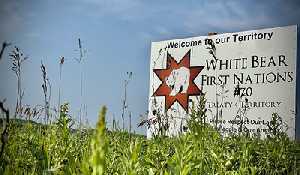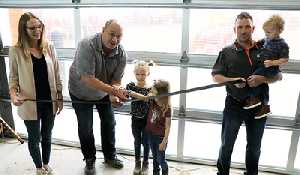Sask Health figures show population is stabilizing
January 20, 2015, 3:06 am
Andrea Jaenen


New covered population statistics released by Saskatchewan Health suggest that the population of some communities in the Moosomin area continues to grow, but overall population in the area is stabilizing.
The covered population statistics are not a census, but report how many people of each age group list a community as home. The covered population includes everyone with a Saskatchewan health card, so it may not include some people who have recently moved from out of province or out of the country, while it may include students who are away at university or those who have recently moved away.
The numbers are collected as of June 30 each year. The numbers for this year were recently released by the health ministry.
The latest numbers from Saskatchewan Health show 3,105 people in Moosomin, up 633 people or more than 25 per cent from 2006.
Moosomin’s number is up 44 from last year’s 3,061, a smaller increase than most recent years.
The overall trend the health ministry’s stats show is a steady increase in population in communities over the last decade, with the population stabilizing over the last two to three years.
In 2005, Moosomin was the only community in the area with more than 1,000 people. In 2006 there were two communities over a thousand, in 2007 there were three, and since 2008 there have been four—Moosomin, Rocanville, Redvers, and Whitewood.
The total covered population of towns and villages in the area was 7,737 in 2007 and 9,717 in 2014.
Rocanville, Redvers, and Whitewood are the other growth stories in the region. Rocanville has grown from 990 to 1,244 over the last decade, Redvers from 991 to 1,383, and Whitewood from 994 to 1,255.
Moosomin Mayor Larry Tomlinson says the smaller increase in population in 2014 shows that growth in Moosomin continues, but is happening at a slower pace.
“I think the potash mine construction is slowing down,” says Tomlinson. “We were really fortunate with the construction at the mine and the new headframe. I think we took good advantage of that, and I think now it is going to stabilize for a bit.
“I think we’ll continue to grow, but at a slower pace.”
Tomlinson says the town has faced numerous challenges over the past few years as the population grew, and says he hopes the town is ready for steady growth into the future.
“The biggest area where it has affected us is infrastructure—water, sewer, trying to keep ahead of that,” he says. “And of course with three floods it made it worse.
“Cheaper housing is a bit of an issue, especially for some of the immigrants.
“We’ve had some challenges—real big challenges. Hopefully we’ve looked after them as they’ve come, but it’s been tough.”
Tomlinson says the town is looking at land for future development for residential lots, and points out that some major projects have been completed over the years to prepare the town for more growth. Projects such as restoring the water tower, expanding the lagoon and putting in a new town well have all taken place recently and will help if the town continues to grow.
“We’ve had all that done in the past few years. We’re ready for a bit of growth if we have the land for what we need.”
What does Tomlinson foresee for the future of Moosomin?
“Let’s grow it. It’s a hub,” he says. “It’s in an excellent location and I think within a 60-mile radius, we’re the hub. We’ve got the amenities for it. Hopefully we can keep growing. And there’s lots on the horizon.”
According to the covered population statistics, the town or Rocanville saw a slight decrease from 1,274 people in 2013 to 1,244 people in 2014. But the town’s director of economic development, Jamie MacLeod, says that’s likely because some of the people working on the PotashCorp expansion have left the community. She points out that since then, new families and new people have moved into town.
“There was an expansion project that was going on here at the mine, so we had a lot of people in town working on that project. That project wrapped up and those people have since left,” she says.
“We’ve had new people move into the community recently so I don’t know if the population has really changed that much.
“We definitely have had new people move into town. I’ve met with them personally. I’ve been handing out welcome wagon bags myself, not just to people in town but to people in the rural municipality as well.
“I think the town is growing. The mine is hiring right now. They just hired 25 new people and I think a few of those families have moved in. I know one family is renting a farm right now. And then we’ve had a couple of lots sold in Cameron Crescent and had some families move in there. One is a supervisor at the mine and they moved from Lanigan. He used to work at PotashCorp in Lanigan and got laid off.
“We’ve had quite a few families move in, and they are four- to five- to six-person families.”
MacLeod says she thinks the town will continue to grow as the years pass.
“Our future is really bright. We’ve got a new development in Cameron Crescent, we have a few lots there, and some new housing going up.
“There’s definitely a lot of growth here, and some new businesses. We’ve got a new restaurant opening up in town here in the next couple of months too.
“I expect it will still be growing and there will still be new families moving in. There’s lots of new activities. I know we have some new events coming up. I find there are a lot of new young families moving into town, so that’s exciting to see them grow and develop and the things that they will bring to the community, and how it will be enhanced.”
MacLeod points out that a number of businesses in town has also expanded over the years as a result of the potash mine expansion, and says the mine has plans to have 100 new permanent employees in place by mid summer.
She says that hiring has already started, with 25 new employees hired recently, and plans for another 25 to be hired by the end of the month. She says the town hopes that some of those families will choose to settle in Rocanville.
“There’s lots of opportunity here, there’s lots of room for growth, and lots of new activities and events coming up all the time,” she says.
Saskatchewan’s population has grown to nearly 1,130,000 according to the latest figures released in December by Statistics Canada.
As of October 1, there were 1,129,899 people living in Saskatchewan, an increase of 4,489 in the past quarter and 18,102 in the past year.
Premier Brad Wall noted it was just seven years ago that Saskatchewan’s population hit one million people.
“Since then, we have seen steady growth of another 130,000 people—nearly 20,000 per year,” Wall said. “That kind of growth creates both opportunities and challenges. One of those challenges will be to keep our economy and our population growing in 2015 in the face of falling oil revenues. Our government will be working hard to meet this challenge through sound fiscal management, continued investment in important infrastructure projects and tax incentives for new growth and job creation.”
Over the past year, Saskatchewan had the second-strongest rate of population growth among the provinces, behind only Alberta.



































